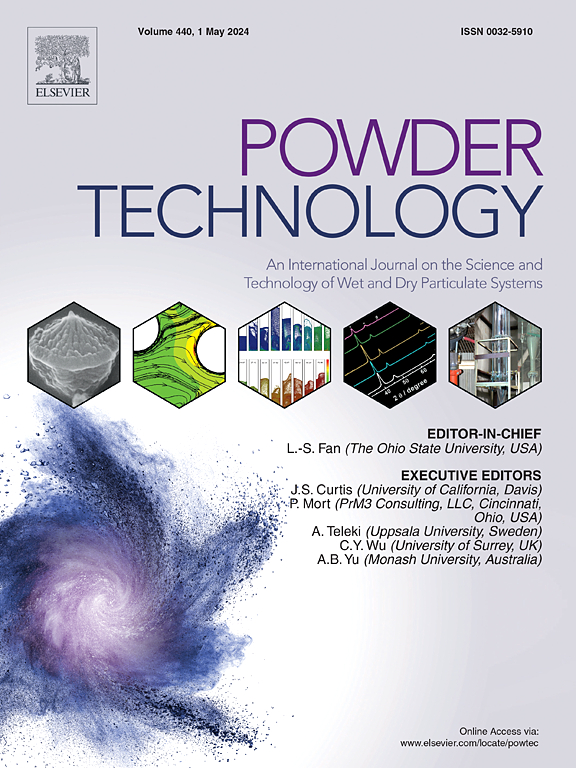Experimental study on stability and hydration process of ultra-fine cement-based slurry
IF 4.5
2区 工程技术
Q2 ENGINEERING, CHEMICAL
引用次数: 0
Abstract
Ultra-fine cement overcomes the limitations of ordinary cement, such as large particle size that hinders injection into micro-cracks and pores, and reduces the high costs of chemical slurries. Rheological properties and water-bleeding significantly affect slurry diffusion and grouting effectiveness. This study investigates the impact of the water-cement ratio, admixtures, and hydration time on water precipitation and the rheological behavior of ultra-fine cement-based slurry. The hydration process, including water migration and transformation, was analyzed to reveal the conversion dynamics of slurry water types. The effects of the water-cement ratio and admixtures on slurry hydration behavior are also discussed. The primary findings of this research are as follows: (1) The rheological parameters, including shear stress and apparent viscosity, of ultra-fine cement-based slurry decrease as the water-cement ratio increases. At a constant water-cement ratio, the rheological behavior follows the order: Ultra-fine cement<Bentonite<Hydroxypropyl methylcellulose. (2) The rate of water-bleeding from the ultra-fine cement-based slurry increases with a higher water-cement ratio. The addition of bentonite slightly reduces the water-bleeding rate. Conversely, hydroxypropyl methylcellulose markedly inhibits the water-bleeding rate of the slurry. (3) This study reveals the mechanism of water migration from capillary pores to gel pores and demonstrates that bentonite slows the hydration rate, while hydroxypropyl methyl cellulose accelerates it. The findings offer valuable theoretical insights and practical guidance for optimizing the use of ultra-fine cement slurry in micro-crack sealing and permeability control applications.

超细水泥基浆体稳定性及水化过程试验研究
超细水泥克服了普通水泥粒度大、难以注入微裂缝和孔隙等局限性,降低了化学浆料的高成本。流变特性和渗水显著影响浆液扩散和注浆效果。本研究考察了水灰比、外加剂和水化时间对超细水泥基浆体的水沉淀和流变性能的影响。分析了水化过程中水分的迁移和转化,揭示了浆料水类型的转化动态。讨论了水灰比和外加剂对料浆水化性能的影响。主要研究结果如下:(1)随着水灰比的增大,超细水泥基浆体的剪切应力和表观粘度等流变参数减小。水灰比一定时,其流变性能表现为:超细水泥;膨润土;羟丙基甲基纤维素。(2)水灰比越高,超细水泥浆的出水率越高。膨润土的加入略微降低了出水速率。相反,羟丙基甲基纤维素显著抑制浆料的出水速率。(3)本研究揭示了水从毛细管孔向凝胶孔迁移的机理,表明膨润土减缓水化速率,羟丙基甲基纤维素加速水化速率。研究结果为优化超细水泥浆在微裂缝密封和渗透率控制中的应用提供了有价值的理论见解和实践指导。
本文章由计算机程序翻译,如有差异,请以英文原文为准。
求助全文
约1分钟内获得全文
求助全文
来源期刊

Powder Technology
工程技术-工程:化工
CiteScore
9.90
自引率
15.40%
发文量
1047
审稿时长
46 days
期刊介绍:
Powder Technology is an International Journal on the Science and Technology of Wet and Dry Particulate Systems. Powder Technology publishes papers on all aspects of the formation of particles and their characterisation and on the study of systems containing particulate solids. No limitation is imposed on the size of the particles, which may range from nanometre scale, as in pigments or aerosols, to that of mined or quarried materials. The following list of topics is not intended to be comprehensive, but rather to indicate typical subjects which fall within the scope of the journal's interests:
Formation and synthesis of particles by precipitation and other methods.
Modification of particles by agglomeration, coating, comminution and attrition.
Characterisation of the size, shape, surface area, pore structure and strength of particles and agglomerates (including the origins and effects of inter particle forces).
Packing, failure, flow and permeability of assemblies of particles.
Particle-particle interactions and suspension rheology.
Handling and processing operations such as slurry flow, fluidization, pneumatic conveying.
Interactions between particles and their environment, including delivery of particulate products to the body.
Applications of particle technology in production of pharmaceuticals, chemicals, foods, pigments, structural, and functional materials and in environmental and energy related matters.
For materials-oriented contributions we are looking for articles revealing the effect of particle/powder characteristics (size, morphology and composition, in that order) on material performance or functionality and, ideally, comparison to any industrial standard.
 求助内容:
求助内容: 应助结果提醒方式:
应助结果提醒方式:


